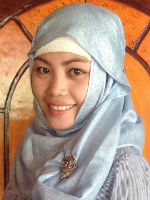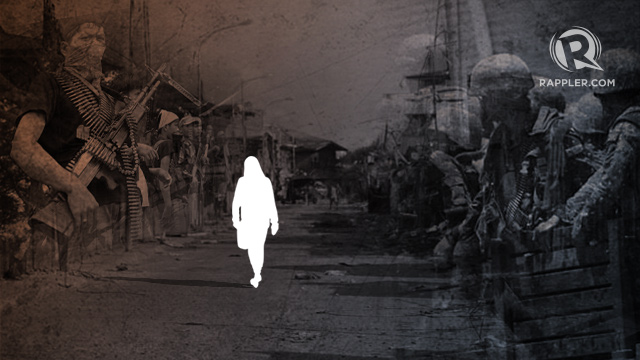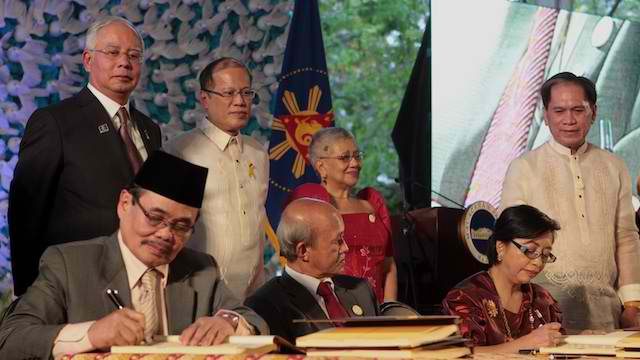SUMMARY
This is AI generated summarization, which may have errors. For context, always refer to the full article.
 Why Bangsamoro?
Why Bangsamoro?
The question lingers.
For someone who has experienced the ugly face of war in Mindanao, the answer would be a complicated narrative between the ideal and the real, of vision and life, and of expectations and the realizations. (TIMELINE: Long road to Bangsamoro)
All-out-war in 2001
I was a freshman student at St. Vincent Academy in Kauswagan, Lanao del Norte when the all-out-war broke in Mindanao during the Estrada administration.
Even though the school was Catholic, I was never discriminated for being a Muslim. This was actually where I realized that it’s not religion that divides, but our prejudices and perceptions of each other. Trust me, I learned it through experience. (READ: FAQs on Bangsamoro peace deal)
Who would have thought that on one sunny weekend in April 2001, we would have to flee our homes because of the armed confrontation between the Armed Forces of the Philippines (AFP) and the Moro Islamic Liberation Front (MILF)?
It’s a painful memory I could never forget. We ran to a pantalan (sea port) located in Poblacion of Kauswagan, as a sort of “backdoor” to relatively safer nearby areas such as Iligan City via bancas.
During the massive evacuation, I observed that Muslims like me and my kin were given last priority to board the bancas. That was the first time I felt terribly discriminated.
I asked myself naïve yet disturbing questions, “Why are human beings so harsh against fellow human beings? What’s the difference between Muslims and Christians? Why do we have to fight against each other?” (READ: Misrepresentation of the ‘other’ and ourselves)
I did not understand.
Since then, I made a pact with myself, “I will search for answers and find resolve to this painful reality which tore our nation apart.”
The Bangsamoro question
My quest for answers and longing for genuine peace in our homeland brought me to the Mindanao State University in Marawi City, where I earned my Bachelor’s degree in Political Science.
I learned the theories, but reality didn’t seem to compliment them – or worst – the “binary opposite” presented itself to me.

Rule of law, social justice, and democracy remain to be elusive like love that was not meant to be. What remained is hope for the things the eyes couldn’t see, but felt by the heart. But I persisted.
My academic quest for social inquiry to address my dilemmas on the so-called “Mindanao conflict” was initially answered by my undergraduate thesis entitled “The Struggle for Indigenous Land Rights: The Case of the 24-hectare Land Conflict in Inudaran, Kauswagaqn, Lanao del Norte.” I found some historical facts on what makes a “Moro” and Muslims distinct from the rest of the Filipino people.
Let me be clear that in this context, the Moros are defined as an Islamized indigenous people. So, what is this “Moro problem” better known today as the “Bangsamoro question?”
The Islamized indigenous people of the Philippines called Muslims were labeled “Moro” by the Spanish colonizers, associating them with the Muslim Moors of Mauritania, Morocco, and the Iberian Peninsula.
Noted for their bravery and maratabat (pride and honor), the Moro Muslims in Mindanao struggled against Spanish colonialism and later resisted American imperialists. The Americans were able to strategically make some concessions with the Moros through their policy of “benevolent assimilation” (westernized education system) and “divide-and-rule” tactics of colonial policies throughout the Philippine archipelago.
Consolidating the 13 ethno-linguistic groups of the Moro populace – namely, the Badjao (SamaDilaut), Iranun, Kalagan (Kagan), Kalibugan (Kolibugan), JamaMapun, Maguinadanaoan, Meranao, Molbog, Palawani, Sama (SamaBalangingi), Sangil (sangir), Tausug, and Yakan – the Bangsamoro identity emerged.
Having been integrated with the rest of the Philippines, arguably, without their consent, they felt systematic marginalization reinforced by the post-colonial policies of the Philippine government.
According to a Mindanao historian, Professor Rudy Rodil, what made it worst was the collective memory on the part of the Bangsamoro people of the stigma that indigenous peoples like the Moros and Lumads felt. They were called “National cultural minorities” within the Republic of the Philippines.
They were branded as the “other” and needed to be civilized.
This “false” narrative was, of course, engrained in the psyche of our fellow Filipino brothers and sisters who had their own share of burden in the colonization era. Needless to say, the tri-people of Mindanao – the Muslims, Christian migrants and their descendants, and the Lumads – used to enjoy peaceful coexistence between and among them.
Yet, it’s not the end of herstory.
Youth’s role in Bangsamoro
Indeed, we have gone a long way and the role of the youth is crucial if we are to “normalize” Philippine society. (READ: A challenge to the Bangsamoro)
As expressed by the Chief Moro Islamic Liberation Front (MILF) negotiator, Mohagher Iqbal, in an interview in August 2013, “Our struggle for genuine political autonomy is to ensure the bright future of the youth in the Bangsamoro.”

As partners for peace building and national development, the youth’s role is critical in building friendship towards harmonious relationships among and between the multi-ethnic, multicultural people of this country. Mindanao is a shared territory.
What is certain in the Comprehensive Agreement in the Bangsamoro (CAB) is the fundamental recognition of the rights of the Christians and the Indigenous People within the proposed Bangsamoro core territory. That is the ideal. Hopefully, it will strengthen the resolve of the Bangsamoro people’s quest for their right to self-determination and socio-economic development.
Interestingly, the Bangsamoro also recognizes the essential role of women in sustaining peace efforts towards holistic development. (READ: Muslim women on discrimination)
Many Filipinos notably recognize the potential of the Bangsamoro region. In a column written by a Filipino economist Cielito Habito, he hinted the strategic link of Mindanao to the Brunei-Indonesia-Malaysia-Philippines East Asia Growth area (BIMP EAGA), relative to the rest of the country.
Zamboanga City, for instance, is a gateway to the country’s neighboring countries Indonesia and Malaysia.
Nonetheless, we have to go beyond the territorial component to the non-materialistic values like security, survival, development, and social responsibility to sustain peace efforts.
Lasting peace
As a student of politics, it goes without saying that it is a (political) “negotiated peace covenant,” which is essential in recognizing the fundamental aspiration of the Bangsamoro people on their continuing struggle for their right to self-determination.
As a Mindanaon, the CAB is at the least, an affirmation of the multicultural society in the Philippines. As Furnival would call it, a plural society – like a medley where they mix but they do not combine – one is distinct from the other. (READ: Lifting the Bangsamoro for good)
The Katwahang Bangsamoro, Katawhang Kristiyano of migrante and the Katawhang Lumad despite their cultural differences share their common vision of a peaceful and humane society.
As a netizen, the “virtual” attention given by those supportive of the peace agreement could not be undermined. More so, constructive criticisms of naysayers are also significant considering the precedents of negotiations. We have to take risks if it can be for the “common good.”
The Bangsamoro people, just like their Filipino brothers and sisters, had suffered enough. They deserve to be given their fair share of economic growth, and democratic governance. We all deserve that, don’t we?
The Bangsamoro is a product of our continuing quest for freedom and a just society. Challenges will always be there to test the strength of “our” capacity to introduce transformative change and good governance to improve the lives of the people in Mindanao and the country as a whole.
The agreement is the backbone of that test. We shall be the ones to make it meaningful.
Finally, every situation provides us a chance to become better versions of ourselves. As the legal provisions for the enactment of the Bangsamoro Basic Law are yet to be seen, we need to provide the social avenue for young people from all walks of life to discuss the merits and demerits of the agreement ensuing productive dialogue for the stakeholders of the Mindanao peace process.
In any worst case scenario, alternative courses of action always start with ideas. After all, one thing is certain in the midst of uncertainty – building a just and lasting peace in Mindanao is an imperative for nation building. – Rappler.com
Yasmira Moner is currently pursing her master’s degree in Political Science in the University of the Philippines-Diliman. Her research interests include conflict and peace studies, state-society relations, and political dynamics. She is also a member of the Young Moro Professionals Network.
Add a comment
How does this make you feel?
There are no comments yet. Add your comment to start the conversation.